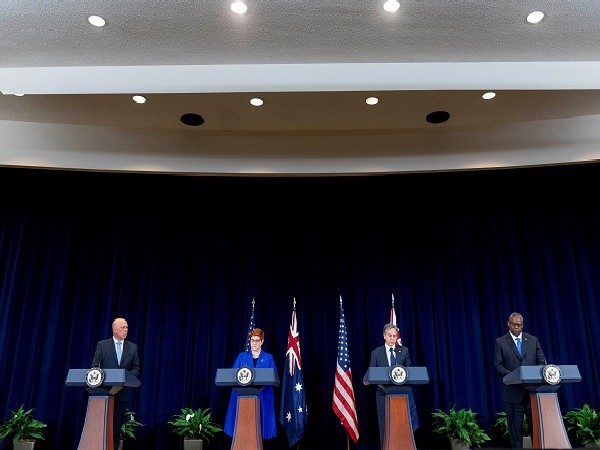HONGKONG: China reacted predictably after the respective leaders of Australia, the UK and USA announced the creation of the trilateral AUKUS strategic alliance.
The response from government and media mouthpieces was one of anger and recrimination.
However, China should look no further than itself as the raison d’etre for the rise of AUKUS.
Zhao Lijian, Chinese Foreign Ministry spokesman, discussed AUKUS, and Australia’s decision to procure nuclear-powered submarines, in a regularly scheduled press conference on 16 September.
In the absence of a separate formal statement from the Foreign Ministry, Zhao’s reactions reflect Beijing’s official stance. He said nuclear submarine cooperation “undermined regional peace and stability, intensified the arms race and undermined international non-proliferation efforts”.
Australia has committed to building at least eight nuclear-powered attack submarines (in naval parlance, an SSN) to replace six ageing Royal Australian Navy (RAN) Collins-class diesel-electric submarines.
Yet, Zhao’s claim ignores China’s own nuclear posture. The People’s Liberation Army Navy (PLAN) already possesses six Type 094 nuclear-powered submarines armed with nuclear-tipped ballistic missiles (known as an SSBN). One was commissioned this year, and two last year.
The PLAN also possesses six Type 093 SSNs, as well as dozens of conventional submarines.
By 2030, the USA predicts the PLAN will have eight SSBNs and 14 SSNs, including improved follow-on submarine classes.
On the other hand, Australia will have no SSBNs and no nuclear weapons. Its submarines will have nuclear propulsion only, which has nothing to do with nuclear weapons. The greatest advantages of a nuclear- powered submarine are range, speed and endurance, as well as power supply for sophisticated onboard sensors. A battery-powered submarine cannot stay submerged as nearly as long.
An RAN nuclear-powered submarine could thus have longer times on station in places like the South China Sea, for example. In the process of opting for nuclear-powered submarines, Australia binned a 2016 contract with Naval Group in France for 12 Attack-class diesel-electric submarines.
ANI had been aware for years that cooperation between Australia and Naval Group was extremely troubled, but the company and French government were taken aback at the dramatic reversal, for which Australian taxpayers will have to fork out millions.
Unfortunately, this decision has alienated France, which was furious at Australia reneging on its deal. With France the only European country with a permanent presence in the Asia-Pacific area, and with Paris having been quite vocal about the illegality of China’s activities in the South China Sea, AUSUK needs to patch up that relationship quickly.
The alliance cannot afford to turn away able likeminded supporters. One wonders why Australia’s decision “undermines regional peace and security”, as Zhao asserts, while China’s far more potent submarine fleet does not. Ironically, Zhao spoke of an arms race.
Obviously it takes more than one competitor to create a race; China is obviously already the frontrunner in that race, and others are reacting to China’s massive military modernization. Zhao also accused London and Washington DC of irresponsibility:
“The export of highly sensitive nuclear submarine technology to Australia by the US and the UK proves once again that they are using nuclear exports as a tool for geopolitical gain and adopting double standards.” In fact, Australia firmly remains a non-nuclear weapon state under the Treaty on the Non-Proliferation of Nuclear Weapons, as Australian Prime Minister Scott Morrison reiterated last week.
However, Zhao said, “The international community, including Australia 39 neighboring countries, has full reason to question whether Australia is serious about fulfilling its nuclear non-proliferation commitments.” China also accused Australia of violating its commitment under the Treaty of Rarotonga.
This treaty includes prohibitions on the production, possession or testing of nuclear weapons, something Canberra is certainly not considering. This is obviously another attempted Chinese smokescreen against Australia. In the meantime, China’s proliferation of nuclear weapons knows no bounds.
The discovery of three huge DF-41 intercontinental ballistic missile (ICBM) silo fields deep in China’s interior, amounting to silos potentially able to accommodate more than 250 ICBMs, is absolutely unprecedented in history.
Admiral Charles A. Richard, head of the US Strategic Command, warned at a symposium last month, “The explosive growth in their nuclear and conventional forces can only be what I describe as breathtaking. Frankly, that word ‘breathtaking’ may not be enough.”
The imminent expansion of China’s DF-41 ICBM arsenal is reinforced by the China Nuclear Engineering and Construction Group announcing a fourfold expansion in military contracts in the first seven months of 2021 compared to last year.
The Foreign Ministry spokesman added, “Relevant countries should abandon the outdated Cold War zero-sum mentality and narrow-minded geopolitical perception, respect the will of the people of regional countries and do more to contribute to regional peace, stability and development. Otherwise, they will only end up shooting themselves in the foot.” Given the multiplication of China’s missile arsenal, it is extremely cynical for Beijing to talk of a “Cold War mentality”.
Of course, this is a typical Chinese expression applied to any security development it does not like. Furthermore, China is militarily threatening Taiwan, with some 2,000 ballistic missiles aimed at the island, and naval and aerial forces threatening Taiwan on a daily basis. This reflects China’s Cold War mentality and its militaristic ambitions.
The Global Times tabloid published a typically aggressive response to the AUKUS announcement, citing experts who said these submarines would “potentially make Australia a target of a nuclear strike if a nuclear war breaks out, even when Washington said it won’t arm Canberra with nuclear weapons, because it’s easy for the US to equip Australia with nuclear weapons and submarine-launched ballistic missiles when Australia has the submarines”.
This is totally disingenuous, and an attempt to muddy the waters. An SSN is simply not capable of launching a nuclear-tipped ballistic missile. Mention of “respecting the will of the people of regional countries” is equally laughable.
China has security or trade tensions with multiple parties such as Australia, Canada, India, Indonesia, Japan, South Korea, Taiwan, Vietnam, the UK and USA.
Others, it has steamrolled or bullied into acquiescence, such as the Philippines. Zhao continued, “China always believes that any regional mechanism should conform to the trend of peace and development of the times and contribute to enhancing mutual trust and cooperation among regional countries. It should not target any third party or undermine its interests.
Seeking a closed and exclusive clique runs counter to the trend of the times and the aspirations of countries in the region, which finds no support and leads nowhere.” This part of Zhao’s statement exposes Beijing’s greatest fear, that free and democratic nations will band together to oppose China’s efforts to bulldoze and dominate.
Calling these “closed and exclusive cliques” is mere name-calling, but it is precisely the thing that terrifies China. Beijing is able to use its considerable economic and geopolitical clout to divide and conquer regional alliances such as ASEAN.
It uses the promise of economic reward in its Belt and Road Initiative, even though Chairman Xi Jinping’s blue-ribbon initiative is designed only to benefit China. It is particularly concerned that this AUKUS alliance sprang from almost nowhere.
For all the confusion and friction that he generated, there was undeniably a titanic shift in approach to China under President Donald Trump.
Under former President Barak Obama, for example, senior US military officials were muzzled in what they can say.
Indeed, Obama was the greatest culprit of all when he accepted Xi’s promise in 2015 that he would not militarize the South China Sea, even as he built sophisticated bases on reclaimed reefs.
Now, however, the Pentagon and US State Department are singing from the same song sheet, and sharp criticism of China is commonplace.
While the three nations studiously avoided mentioning China anywhere in their AUKUS statements or press conferences, it does not take a genius to realize that China was the reason for its creation.
This was evinced in such phrases as support for a “world that favors freedom, respects dignity and the rule of law,” an oblique dig at China’s flouting of international law in places like the South China Sea.
With AUKUS, the USA has rallied important allies to meet the threat from China, and nuclear-powered submarines for Australia are but one aspect of that alliance. Interestingly, Canada and New Zealand are not part of AUKUS, though they remain important partners in the Five Eyes intelligence apparatus.
The AUKUS partners will take the next 18 months to figure out the way forward in developing a customized Australian submarine. Whether it will be based on the American Virginia class or British Astute class remains to be seen.
Given that the submarines will still have to be developed and then constructed in Australia, they will not be making an appearance any time before the late 2030s. There are rumors that, in the meantime, Australia could lease American submarines or even cross-deck crews.
Another aspect to AUKUS is the stationing of American troops, equipment, weapons and platforms on the Australian continent. It is thus likely that the RAN naval base in Western Australia could host American submarines in coming years. A broadening of American basing in Australia will be hugely disconcerting for China.
At the moment, the US military presence in Indo-Pacific concentrates on Japan and South Korea, and then a rotational US Marine Corps detachment in Darwin and an air base in Diego Garcia in the Indian Ocean. It has treaties or agreements with the Philippines, Thailand and Singapore, but these add little heft to American military power in the region. Greater access to Australia would be a completely different story, giving the US a southern anchor to base its “containment” of China.
Indeed, this AUSUK alliance reflects some of China’s worst fears. It is a security alliance that links disparate parts of the world – Europe, the Americas and Australasia. It also helps encircle China, one of the PLA’s greatest fears. A rejuvenated Quad – comprising Australia, India, Japan and the USA – is yet another security alliance that China is concerned about. Indeed, the Quad leaders will meet in person on 28 September. There can be no doubt that China is now reaping what it has sown. It is seeing many countries close ranks and align themselves against itself, as resistance hardens to Chinese actions and ambition. China certainly does not want others joining such formal groupings. Beijing would accuse such “exclusionary blocs” of “ideological prejudice”.
Incidentally, of necessity and perhaps by choice, China prefers to go it alone. Beijing has failed to piece together important strategic alliances of its own, except perhaps with Pakistan and relatively good cooperation with Russia. However, trust is not something that many nations freely place in China.
Interestingly, the UK has long had little military influence in the region, with just a battalion of British Army Gurkhas stationed in Brunei. Currently, however, a Royal Navy aircraft carrier is leading a multinational task force around the Indo-Pacific area.
Xi’s regime is not concerned only about Australia obtaining nuclear-powered submarines, but about the precedent being set. Other countries such as Canada, Japan and South Korea may want to obtain such submarines too.
Certainly, South Korea is the furthest along this avenue, as the country’s navy is agitating for such assets to counter North Korean advances such as submarine-launched ballistic missiles.
Of course, AUSUK is about a lot more than mere submarines. Asia is a hotbed of innovation, and as new disruptive technologies such as quantum computing, cyber advances, stealth technology, unmanned systems, artificial intelligence and hypersonic missiles emerge, AUSUK offers the kind of technology sharing necessary to counter China.
No single nation can go it alone against China, not even the USA. Strength is found in multilateralism, and AUSUK marks the fructification of Beijing’s worst fears – a strong regional security alliance with the USA as the cornerstone. China fears the strength that comes from multilateralism, as it diminishes Beijing’s ability to coerce. (ANI)









Comment